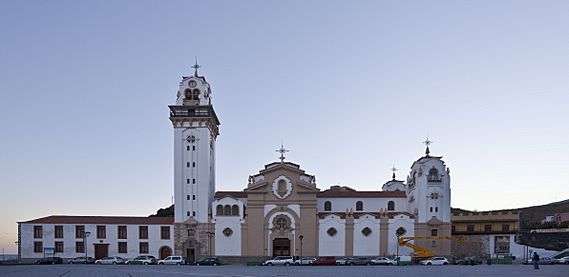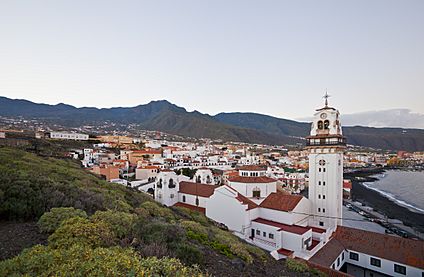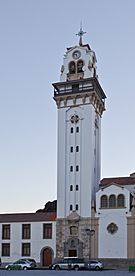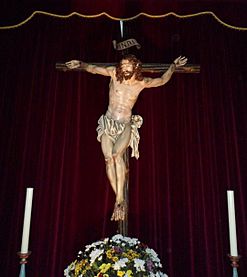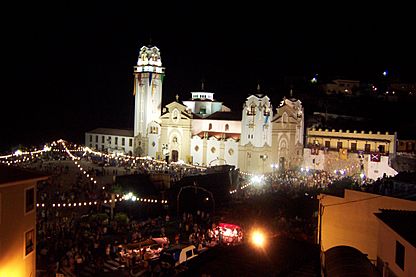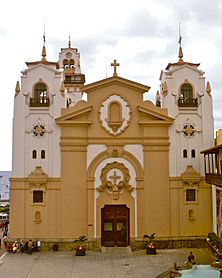Basilica of Candelaria facts for kids
Quick facts for kids Basilica of Our Lady of Candelaria |
|
|---|---|
|
Basílica Nuestra Señora de Candelaria
|
|
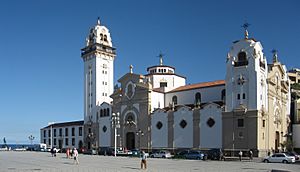
Basilica of Our Lady of Candelaria
|
|
| Religion | |
| Affiliation | Roman Catholic |
| District | Diocese of San Cristóbal de La Laguna |
| Province | Archdiocese of Seville |
| Ecclesiastical or organizational status | Minor basilica, Royal Marian shrine and conventual church |
| Year consecrated | 1959 |
| Location | |
| Location | Candelaria, Tenerife, Spain. |
| Architecture | |
| Architect(s) | José Enrique Marrero Regalado |
| Architectural style | Neoclassicism |
| Groundbreaking | 1949 |
| Completed | 1959 |
| Specifications | |
| Direction of façade | West |
| Capacity | 5000 |
The Basilica of Our Lady of Candelaria is a very important Roman Catholic church in the Canary Islands, Spain. It's located in the town of Candelaria on the island of Tenerife. This beautiful church is dedicated to the Virgin of Candelaria, who is considered the special protector of the Canary Islands. It's about 20 kilometers south of Santa Cruz de Tenerife, the island's capital.
The basilica was designed by an architect named José Enrique Marrero Regalado. It's recognized as a special "Site of Cultural Interest" by the government of the Canary Islands. The statue of the Virgin of Candelaria is a black Madonna, which means it's a statue of Mary with dark skin.
Contents
Discovering the Virgin of Candelaria
How the Statue Was Found
The story of the Virgin of Candelaria began in 1390. Back then, Candelaria was a quiet place where guanches (the native people of the Canary Islands) herded their goats. One evening, two goat herders saw their animals refusing to go near a ravine. They went to check and found a statue of the Virgin of Candelaria on a rock. This statue later became the main patron saint of the Canary Islands.
From Cave to Church
The statue was found on a beach close to Candelaria. It was first taken to the cave of Chinguaro, which was the home of the king of Güímar, a local kingdom. Later, the Guanches moved the statue to the cave of Achbinico in Candelaria. They began to worship it there. At first, the Guanches thought the statue was their goddess Chaxiraxi. But Christian explorers later recognized it as a statue of the Virgin Mary. Soon after, a small chapel was built near the cave. This cave also became a burial place for Christians who loved the Virgin.
Royal Protection and New Buildings
In 1596, King Philip II of Spain declared himself the protector of the Virgin of Candelaria. After he became king, he gave the church the special title of "Royal." This made it the first church in the Canary Islands to receive such an honor.
The current basilica was built on the site of an older church that was destroyed by fire in 1789. However, building the new church took a long time. There were delays due to difficult times, including economic problems and major wars like World War II and the Spanish Civil War.
Finally, the bishop of Tenerife, Domingo Pérez Cáceres, pushed for the construction. He hired architect Jose Enrique Marrero Regalado. The new church was designed to mix different styles found in the Canary Islands. People from all the islands donated money to help build it. The basilica took almost ten years to finish.
A Place of Pilgrimage
On February 1, 1959, the basilica was officially opened in a big religious ceremony. Today, Candelaria is the most important Catholic pilgrimage site in the Canary Islands. It's also one of the main ones in Spain. More than 2.5 million people visit the basilica every year. The Basilica of Our Lady of Candelaria is large enough to hold up to 5,000 people.
Many important people have visited the basilica. These include leaders, church officials, and even the former kings of Spain, Juan Carlos I and Sofia of Greece. They visited in 1977, both as princes and later as kings.
The church was given the special title of a minor basilica by Pope Benedict XVI on January 24, 2011. This title was celebrated on February 2 of that year, which is the feast day of Candlemas.
The basilica attracts not only Catholic pilgrims but also people from other religions. For example, some people from the Hindu community in Tenerife have donated special robes for the Virgin's statue. Every May, a festival called the Intercultural Festival India - Canary Islands is held in the Plaza de la Patrona de Canarias. This festival shares Hindu traditions through food and culture.
Exploring the Basilica's Interior
The inside of the basilica is very impressive. You'll see many mural paintings, especially around the altar. These paintings often show angels and other saints from the Canary Islands who were devoted to the Virgin of Candelaria.
On one side of the main altar, you'll see the flag of Vatican City. This shows the close connection the church has with the Pope because it is a minor basilica. The statue of the Virgin is placed above the altar.
Here are some special areas inside the basilica:
- The Camarín de la Virgen de Candelaria is a room right behind the altar. This is where the wooden statue of the Virgin of Candelaria is kept. It's usually opened after mass.
- The Capilla del Sagrario is next to the sacristy (a room where sacred items are kept). It has a mural painting by José Aguiar that shows the Last Supper of Jesus with his apostles. The chapel windows also show scenes of the Virgin appearing to the Guanches.
- The Capilla del Cristo de la Reconciliación was blessed on April 19, 1996. It features a statue of the crucified Christ made by artist Ricardo Rivera Martínez in 1936. This chapel is used for confessions. The statue of Jesus Christ was inspired by the Shroud of Turin, especially how the nails are placed in his hands.
- The Sala de las Velas (Room of Candles) is near the main entrance. It gets its name from the candles and flowers that people leave as offerings. In this room, there's a painting of the Virgin of Candelaria's "Canonical Coronation." You can also find phrases here that tell the story of the Virgin and her church.
Festivals and Visiting Hours
Annual Celebrations
Every year on August 14 and 15, the basilica welcomes many pilgrims. They come to celebrate the feast day of the Virgin of Candelaria. On August 14, there's a special procession called the "Romeria" and a play that shows how the Virgin appeared. On August 15, a solemn Mass (church service) is held, followed by a procession with important religious, political, and military leaders from the Canary Islands.
Another important celebration is on February 2, the Fiesta de la Candelaria. Pilgrims also come to the basilica for this day. On February 1, there's a torchlight procession around the basilica. On February 2, another Mass and procession take place, led by the Bishop of Tenerife and other important officials.
When to Visit
The Basilica of Our Lady of Candelaria is open almost every day of the year. Here are the opening hours and Mass times:
- Basilica Opening Hours:
- Closed Monday mornings.
- Monday afternoons: 3:00 PM to 7:00 PM.
- Tuesday to Sunday and holidays: 7:30 AM to 7:30 PM.
- Mass Times:
- Monday: 6:00 PM.
- Tuesday to Saturday: 8:00 AM and 6:00 PM.
- Sundays and holy days: 8:00 AM, 10:00 AM, 12:00 PM, and 6:00 PM.
Gallery
See also
 In Spanish: Basílica de Nuestra Señora de la Candelaria para niños
In Spanish: Basílica de Nuestra Señora de la Candelaria para niños
- Roman Catholic Diocese of San Cristóbal de La Laguna
- Virgin of Candelaria
- Plaza de la Patrona de Canarias
- Cathedral of La Laguna
- Real Santuario del Santísimo Cristo de La Laguna
- Basilica of Our Lady of Candelaria (Medellín, Colombia)



